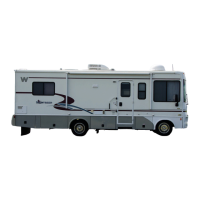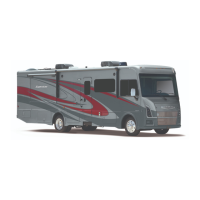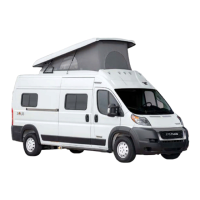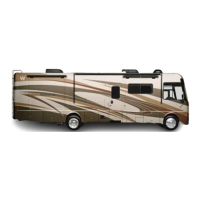Do you have a question about the Winnebago Sightseer 29R and is the answer not in the manual?
Guidance on the purpose and scope of the operator manual.
Explanation of safety alert symbols (Danger, Warning, Caution, Note) used in the manual.
Details on the pre-delivery inspection process and dealer responsibilities.
Guidance on checking and adjusting front axle alignment for optimal performance.
Information on obtaining service and assistance from dealers and manufacturers.
Procedure for reporting vehicle safety defects to the National Highway Traffic Safety Administration.
Details on the information contained on the vehicle certification label.
Technical specifications and fluid capacities for various motor home models.
Section for recording owner, vehicle, dealer, and insurance policy details.
Overview of the limited warranty coverage, exclusions, and owner responsibilities.
Essential safety precautions for operating the motor home, including seat belt use and emergency exits.
Recommendations for safe driving, including handling slippery surfaces and slideout room operation.
Critical safety information regarding the use and handling of fuel and propane gas systems.
Procedures for identifying and responding to propane gas leaks.
Information on the function and operation of the propane gas leak detector.
Precautions against carbon monoxide exposure from exhaust and combustion sources.
Details on the coach's carbon monoxide alarm, its power source, and maintenance.
Information on the smoke alarm's location, power, and replacement recommendations.
Guidance on the location, inspection, and replacement of the fire extinguisher.
Warnings and precautions for safe handling of electrical components and systems.
Guidelines for securing items and understanding weight limits for safe loading.
Safety advice for performing maintenance, including coolant checks and jack usage.
Instructions for using emergency exits, including the escape window and slider windows.
Information on formaldehyde emissions and the importance of proper ventilation.
Guidance on preventing and managing mold growth, and its potential health effects.
Steps to take in roadside emergencies, including flat tire procedures and recovery towing.
Instructions for using the battery boost switch or jumper cables for starting.
Procedure for handling engine overheating conditions and potential hazards.
Instructions for adjusting driver and co-pilot seats for comfort and safety.
How to fold the dinette seat for front seat reclining or access.
Proper use, adjustment, fastening, and care of seat belts for occupant safety.
Guidelines for selecting and securely installing child restraint systems.
Information on identifying and obtaining duplicate keys for the motor home.
How to use the rearview camera monitor for maneuvering and safety.
Instructions for adjusting power electric mirrors and mirror heaters.
Explanation of the brake-shift interlock preventing movement from Park.
Instructions for operating foot-pedal and automatic/pull-button parking brakes.
How to use the grade brake to control speed on downhill grades and avoid overheating.
How to use the overdrive switch to deactivate automatic overdrive for specific driving conditions.
Using Tow/Haul mode for towing to reduce gear hunting and improve performance.
How to operate the driver's side map light.
Function and activation of hazard warning flashers for safety.
Using the battery boost switch to start the engine with house batteries.
Controls for the dash-mounted air conditioner, heater, and defroster.
How to operate the auxiliary rear coach heater if equipped.
Operation of the two-speed defrost fans for windshield clearing.
Information on operating the AM/FM stereo, CD, and DVD player.
Location and identification of CB radio power wiring.
How to access engine components from the exterior hood panel.
Procedure for removing and reinstalling the interior engine access cover.
Precautions for checking and maintaining the engine cooling system.
Function of the chassis battery disconnect switch for conserving battery charge.
Importance of proper tire pressure and checking for wear.
Guidance on suspension alignment and tire balancing for vehicle handling and wear.
Procedure for checking all exterior lights for proper operation before trips.
Location and reset procedure for automotive 12-volt circuit breakers and fuses.
Special techniques for climbing and descending hills in mountainous terrain.
How to operate the refrigerator on AC or propane and ensure proper leveling.
How to open and access the exterior refrigerator service compartment.
Operating instructions for the propane gas range and oven.
Information on operating the microwave oven.
Description of the range hood's ventilation and lighting features.
Checking the condition of utility systems using the Systems Monitor Panel.
Instructions for operating the water heater using propane gas.
Using the dual power feature of the gas/electric water heater.
How the motor aid system uses engine heat to heat water while driving.
Information on the water heater's pressure-temperature relief valve and air gap replacement.
Step-by-step guide for starting up and operating the propane gas furnace.
How the heat pump operates for heating and its efficiency limitations.
Operation of the ducted roof air conditioning system controlled by the thermostat.
How the EMS monitors and distributes electrical loads for efficiency.
Selecting the correct power source (shoreline or generator) for the rear AC unit.
Chart detailing system functions based on thermostat and fan speed settings.
Explanation of the propane gas system, its components, and how it functions.
Essential safety precautions for using the propane gas system.
Detailed warnings and precautions for handling propane gas and preventing leaks.
Information on the propane gas pressure regulator, its protection, and maintenance.
Understanding propane vaporization issues and solutions in cold weather.
Description of the coach's electrical system, including battery and household current.
General safety precautions for working with electrical components and batteries.
How the 120-volt AC system operates from shoreline or generator power.
Instructions for connecting the external power cord to utility services.
Location and function of the power center, converter, and breaker panels.
How 120-volt AC circuit breakers protect against overloads and shorts.
Information on standard household electrical outlets and their locations.
Operation and safety of GFCI outlets for protection against electrical shock.
Instructions for using the 120-volt generator, including operation and hourmeter.
Description of the 12-volt DC system, including chassis battery and house batteries.
How to use the AUX BATT disconnect switch to prevent battery drain during storage.
Instructions for accessing batteries and essential battery care and maintenance practices.
Protection of 12-volt circuits by fuses and breakers and replacement procedures.
Description of the fresh water system, including sources and filling procedures.
How to operate the water pump for the self-contained water system.
Procedure for disinfecting the potable water system with chlorine bleach.
Explanation of the shower hose vacuum breaker and normal water dripping.
How to use the exterior wash station for rinsing and bathing.
Information on toilet operation, important 'don'ts', and care instructions.
How to open and close water drain valves for winterizing or sanitizing.
Using the water heater bypass valve for easier winterization.
Two methods for winterizing the plumbing system to prevent freezing damage.
Chart detailing the locations of various water system drain valves by model.
How the front TV operates only when the ignition key is off or in accessory position.
Basic operation of the audio-video system, including sound and video input settings.
Turning off the bedroom TV's pre-heat circuit to avoid battery drain.
Using the inverter to power TV and DVD player from house batteries.
Instructions for raising, rotating, and lowering the TV antenna for optimal signal.
How to use the TV signal amplifier for better reception.
Location of the cable television connector for hook-up.
Information on pre-wiring for a digital satellite TV system and connection locations.
Guidance for operating the digital satellite TV system and aiming the antenna dish.
Description of the exterior entertainment center with radio, CD player, and TV hook-up.
How to use the glide-lock mechanism and chair base clamp for safety.
Warning against using sleeping facilities while the vehicle is in motion.
Instructions for converting the sofa to a bed and vice versa.
How to convert the dinette seating area into a bed.
Using the two-stage blinds for light filtering, darkening, or privacy.
Information on the types of wood used and their natural characteristics.
How to release and secure the slideout room travel lock.
Operating slideout rooms using electric switches and safety precautions.
Recommendations for retracting slideout rooms during extreme weather conditions.
Troubleshooting electric slideout rooms, including battery and circuit breaker issues.
Procedure for manually retracting electric slideout rooms in case of malfunction.
Manual retraction process for the bedroom slideout room using crank tools.
Tips for maintaining slideout room seals and cleaning floors before retraction.
How to use the hydraulic leveling system for parking site adjustment.
Procedure for checking the hydraulic oil level in the leveling system.
Importance of inspecting and maintaining sealants to prevent water entry.
Safety precautions for walking on the roof and inspecting roof sealant.
How to clean the undercarriage to prevent rust and corrosion.
Precautions for maintaining the automotive paint finish, including parking and driving advice.
Tips for cleaning and maintaining exterior appliques and decals.
How to clean plastic parts, recommending mild cleaners and avoiding harsh chemicals.
Recommendations for vacuuming and cleaning interior fabrics and carpets.
Guidelines for cleaning and removing stains from ceiling fabrics.
How to clean wooden and vinyl cabinetry using appropriate products.
Maintaining tables and countertops with protective wax and proper cleaning.
Instructions for cleaning and maintaining the acrylic galley sink.
Refer to manufacturer manuals for care of range and refrigerator.
Refer to manufacturer manuals for care of the toilet.
How to clean windows and care for door locks and hinges.
Steps for preparing the motor home for storage, including propane and battery checks.
Procedure for bringing the motor home out of storage and checking systems.
Recommended maintenance intervals for various coach systems and components.
Diagram and guide for recommended sealant application locations on the coach exterior.
Guidelines for distributing cargo weight to avoid exceeding axle or vehicle ratings.
How to weigh the fully loaded coach and determine proper load distribution.
Information on hitch capacity, tongue weight, and towing vehicle compatibility.
Diagram showing proper connection of trailer or tow vehicle wiring to the coach.
Explanation of GVWR, GAWR, GCWR, and towing weight distribution.
How the electric entry step operates automatically or in stationary extended mode.
Instructions for operating crank-out and horizontal slider windows.
How to operate the ceiling ventilator, including dome raising and fan control.
Refer to manufacturer manual for operating the manual awning.
Information on storage compartment gaskets and ensuring proper latching.
Description of where various tools supplied with the coach are stored.
Operation of the compartment lights switch and recommendations for storage.
Safety warnings and inspection guidelines before using the roof ladder.
Managing condensation and humidity during extended occupancy.
Guidance on the purpose and scope of the operator manual.
Explanation of safety alert symbols (Danger, Warning, Caution, Note) used in the manual.
Details on the pre-delivery inspection process and dealer responsibilities.
Guidance on checking and adjusting front axle alignment for optimal performance.
Information on obtaining service and assistance from dealers and manufacturers.
Procedure for reporting vehicle safety defects to the National Highway Traffic Safety Administration.
Details on the information contained on the vehicle certification label.
Technical specifications and fluid capacities for various motor home models.
Section for recording owner, vehicle, dealer, and insurance policy details.
Overview of the limited warranty coverage, exclusions, and owner responsibilities.
Essential safety precautions for operating the motor home, including seat belt use and emergency exits.
Recommendations for safe driving, including handling slippery surfaces and slideout room operation.
Critical safety information regarding the use and handling of fuel and propane gas systems.
Procedures for identifying and responding to propane gas leaks.
Information on the function and operation of the propane gas leak detector.
Precautions against carbon monoxide exposure from exhaust and combustion sources.
Details on the coach's carbon monoxide alarm, its power source, and maintenance.
Information on the smoke alarm's location, power, and replacement recommendations.
Guidance on the location, inspection, and replacement of the fire extinguisher.
Warnings and precautions for safe handling of electrical components and systems.
Guidelines for securing items and understanding weight limits for safe loading.
Safety advice for performing maintenance, including coolant checks and jack usage.
Instructions for using emergency exits, including the escape window and slider windows.
Information on formaldehyde emissions and the importance of proper ventilation.
Guidance on preventing and managing mold growth, and its potential health effects.
Steps to take in roadside emergencies, including flat tire procedures and recovery towing.
Instructions for using the battery boost switch or jumper cables for starting.
Procedure for handling engine overheating conditions and potential hazards.
Instructions for adjusting driver and co-pilot seats for comfort and safety.
How to fold the dinette seat for front seat reclining or access.
Proper use, adjustment, fastening, and care of seat belts for occupant safety.
Guidelines for selecting and securely installing child restraint systems.
Information on identifying and obtaining duplicate keys for the motor home.
How to use the rearview camera monitor for maneuvering and safety.
Instructions for adjusting power electric mirrors and mirror heaters.
Explanation of the brake-shift interlock preventing movement from Park.
Instructions for operating foot-pedal and automatic/pull-button parking brakes.
How to use the grade brake to control speed on downhill grades and avoid overheating.
How to use the overdrive switch to deactivate automatic overdrive for specific driving conditions.
Using Tow/Haul mode for towing to reduce gear hunting and improve performance.
How to operate the driver's side map light.
Function and activation of hazard warning flashers for safety.
Using the battery boost switch to start the engine with house batteries.
Controls for the dash-mounted air conditioner, heater, and defroster.
How to operate the auxiliary rear coach heater if equipped.
Operation of the two-speed defrost fans for windshield clearing.
Information on operating the AM/FM stereo, CD, and DVD player.
Location and identification of CB radio power wiring.
How to access engine components from the exterior hood panel.
Procedure for removing and reinstalling the interior engine access cover.
Precautions for checking and maintaining the engine cooling system.
Function of the chassis battery disconnect switch for conserving battery charge.
Importance of proper tire pressure and checking for wear.
Guidance on suspension alignment and tire balancing for vehicle handling and wear.
Procedure for checking all exterior lights for proper operation before trips.
Location and reset procedure for automotive 12-volt circuit breakers and fuses.
Special techniques for climbing and descending hills in mountainous terrain.
How to operate the refrigerator on AC or propane and ensure proper leveling.
How to open and access the exterior refrigerator service compartment.
Operating instructions for the propane gas range and oven.
Information on operating the microwave oven.
Description of the range hood's ventilation and lighting features.
Checking the condition of utility systems using the Systems Monitor Panel.
Instructions for operating the water heater using propane gas.
Using the dual power feature of the gas/electric water heater.
How the motor aid system uses engine heat to heat water while driving.
Information on the water heater's pressure-temperature relief valve and air gap replacement.
Step-by-step guide for starting up and operating the propane gas furnace.
How the heat pump operates for heating and its efficiency limitations.
Operation of the ducted roof air conditioning system controlled by the thermostat.
How the EMS monitors and distributes electrical loads for efficiency.
Selecting the correct power source (shoreline or generator) for the rear AC unit.
Chart detailing system functions based on thermostat and fan speed settings.
Explanation of the propane gas system, its components, and how it functions.
Essential safety precautions for using the propane gas system.
Detailed warnings and precautions for handling propane gas and preventing leaks.
Information on the propane gas pressure regulator, its protection, and maintenance.
Understanding propane vaporization issues and solutions in cold weather.
Description of the coach's electrical system, including battery and household current.
General safety precautions for working with electrical components and batteries.
How the 120-volt AC system operates from shoreline or generator power.
Instructions for connecting the external power cord to utility services.
Location and function of the power center, converter, and breaker panels.
How 120-volt AC circuit breakers protect against overloads and shorts.
Information on standard household electrical outlets and their locations.
Operation and safety of GFCI outlets for protection against electrical shock.
Instructions for using the 120-volt generator, including operation and hourmeter.
Description of the 12-volt DC system, including chassis battery and house batteries.
How to use the AUX BATT disconnect switch to prevent battery drain during storage.
Instructions for accessing batteries and essential battery care and maintenance practices.
Protection of 12-volt circuits by fuses and breakers and replacement procedures.
Description of the fresh water system, including sources and filling procedures.
How to operate the water pump for the self-contained water system.
Procedure for disinfecting the potable water system with chlorine bleach.
Explanation of the shower hose vacuum breaker and normal water dripping.
How to use the exterior wash station for rinsing and bathing.
Information on toilet operation, important 'don'ts', and care instructions.
How to open and close water drain valves for winterizing or sanitizing.
Using the water heater bypass valve for easier winterization.
Two methods for winterizing the plumbing system to prevent freezing damage.
Chart detailing the locations of various water system drain valves by model.
How the front TV operates only when the ignition key is off or in accessory position.
Basic operation of the audio-video system, including sound and video input settings.
Turning off the bedroom TV's pre-heat circuit to avoid battery drain.
Using the inverter to power TV and DVD player from house batteries.
Instructions for raising, rotating, and lowering the TV antenna for optimal signal.
How to use the TV signal amplifier for better reception.
Location of the cable television connector for hook-up.
Information on pre-wiring for a digital satellite TV system and connection locations.
Guidance for operating the digital satellite TV system and aiming the antenna dish.
Description of the exterior entertainment center with radio, CD player, and TV hook-up.
How to use the glide-lock mechanism and chair base clamp for safety.
Warning against using sleeping facilities while the vehicle is in motion.
Instructions for converting the sofa to a bed and vice versa.
How to convert the dinette seating area into a bed.
Using the two-stage blinds for light filtering, darkening, or privacy.
Information on the types of wood used and their natural characteristics.
How to release and secure the slideout room travel lock.
Operating slideout rooms using electric switches and safety precautions.
Recommendations for retracting slideout rooms during extreme weather conditions.
Troubleshooting electric slideout rooms, including battery and circuit breaker issues.
Procedure for manually retracting electric slideout rooms in case of malfunction.
Manual retraction process for the bedroom slideout room using crank tools.
Tips for maintaining slideout room seals and cleaning floors before retraction.
How to use the hydraulic leveling system for parking site adjustment.
Procedure for checking the hydraulic oil level in the leveling system.
Importance of inspecting and maintaining sealants to prevent water entry.
Safety precautions for walking on the roof and inspecting roof sealant.
How to clean the undercarriage to prevent rust and corrosion.
Precautions for maintaining the automotive paint finish, including parking and driving advice.
Tips for cleaning and maintaining exterior appliques and decals.
How to clean plastic parts, recommending mild cleaners and avoiding harsh chemicals.
Recommendations for vacuuming and cleaning interior fabrics and carpets.
Guidelines for cleaning and removing stains from ceiling fabrics.
How to clean wooden and vinyl cabinetry using appropriate products.
Maintaining tables and countertops with protective wax and proper cleaning.
Instructions for cleaning and maintaining the acrylic galley sink.
Refer to manufacturer manuals for care of range and refrigerator.
Refer to manufacturer manuals for care of the toilet.
How to clean windows and care for door locks and hinges.
Steps for preparing the motor home for storage, including propane and battery checks.
Procedure for bringing the motor home out of storage and checking systems.
Recommended maintenance intervals for various coach systems and components.
Diagram and guide for recommended sealant application locations on the coach exterior.
Guidelines for distributing cargo weight to avoid exceeding axle or vehicle ratings.
How to weigh the fully loaded coach and determine proper load distribution.
Information on hitch capacity, tongue weight, and towing vehicle compatibility.
Diagram showing proper connection of trailer or tow vehicle wiring to the coach.
Explanation of GVWR, GAWR, GCWR, and towing weight distribution.
How the electric entry step operates automatically or in stationary extended mode.
Instructions for operating crank-out and horizontal slider windows.
How to operate the ceiling ventilator, including dome raising and fan control.
Refer to manufacturer manual for operating the manual awning.
Information on storage compartment gaskets and ensuring proper latching.
Description of where various tools supplied with the coach are stored.
Operation of the compartment lights switch and recommendations for storage.
Safety warnings and inspection guidelines before using the roof ladder.
Managing condensation and humidity during extended occupancy.
| Manufacturer | Winnebago |
|---|---|
| Model | Sightseer 29R |
| Chassis | Ford F53 |
| Horsepower | 350 hp |
| Torque | 468 lb-ft |
| Transmission | 6-speed automatic |
| Category | Motorhomes |
| Gross Vehicle Weight Rating (GVWR) | 18, 000 lbs |
| Fuel Capacity | 80 gal. |
| LP Gas Capacity | 18 gallons |
| Engine | 7.3L V8 |












